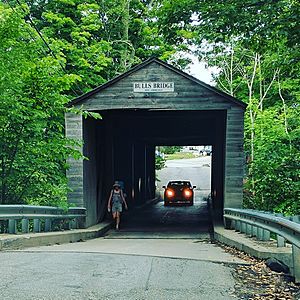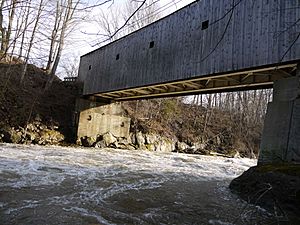Bull's Bridge facts for kids
Quick facts for kids Bull's Bridge |
|
|---|---|

Traffic on Bull's Bridge crossing the Housatonic River
|
|
| Coordinates | 41°40′32″N 73°30′34″W / 41.67556°N 73.50944°W |
| Carries | Bull's Bridge Road |
| Crosses | Housatonic River |
| Locale | Kent, Connecticut |
| Official name | Bridge No. 4453 |
| Maintained by | Connecticut Department of Transportation |
| Characteristics | |
| Design | Lattice truss bridge |
| Material | wood |
| Total length | 33.2 metres (109 ft) |
| History | |
| Opened | 1842 |
| Statistics | |
| Toll | None |
Bull's Bridge is a special wooden covered bridge in Kent, Connecticut. It crosses the Housatonic River and is only for one lane of traffic. This bridge is very old, with the first one built in 1760 by Jacob and Isaac Bull. That's how it got its name!
A cool legend says that George Washington himself crossed the bridge while it was still being built. The bridge you see today was constructed in 1842. It's important because it's one of only three covered bridges left in Connecticut. It was added to the National Register of Historic Places in 1972.
Contents
Where is Bull's Bridge Located?
Bull's Bridge is about 109 feet (33.2 meters) long. It stretches over the Housatonic River in the northwest part of Connecticut. This spot is very close to the border with New York State.
The main road, US Route 7, is nearby. It runs alongside the river. This area is mostly forests and is great for outdoor activities. People love to go hiking and do watersports here. The bridge is also near a hydroelectric dam outlet. Waterfalls and rapids make this a popular place for tourists to visit.
Why is This Bridge Special?
Bull's Bridge is one of only three public covered bridges left in Connecticut. It's also one of two that cars can still drive on. Because it's a single-lane bridge, drivers have to take turns crossing.
The bridge has lasted so long because it's built very strong. The cover protects the wooden floor from bad weather. This stops the wood from rotting away. Also, the bridge is built high above the river. This means it's safer from floods caused by melting snow in spring.
The History of Bull's Bridge

People have been crossing the Housatonic River at this spot since the 1700s. The first bridge was built in 1760 by Jacob Bull and his son, Isaac. They used it to move pig iron from Bull's metal factory to Poughkeepsie, New York. They built it here because it was the narrowest part of the river.
Some historians say this bridge was used to transport iron ore during the American Revolutionary War. Bridges back then didn't last very long, maybe only seven to ten years. So, there were probably many bridges built here over time. Floods and ice often damaged them.
A Safe Place to Cross
Long ago, the bridge was also seen as a safe place. If someone had broken a "Blue Law" in Connecticut, they could cross the bridge into New York. This made it harder for Connecticut authorities to catch them.
George Washington's Connection
A famous person named William Samuel Johnson built another bridge around 1773. This bridge connected his "Iron Works" to his brother-in-law's farm. During the American Revolutionary War, this road became very important.
General George Washington visited the farm several times. He was said to think highly of the patriotic widow who ran the farm. Later, William Samuel Johnson married this widow.
The Bridge We See Today
The current Bull's Bridge was built in 1842. It uses a special design called a "Town lattice." This design was invented by Ithiel Town, who might have even helped build this bridge. The bridge has wooden planks on its sides and a roof made of wood shingles.
The bridge used to charge a toll to cross. It cost 6 cents for a horse and carriage and 3 cents for people walking. These tolls were stopped in 1867. The bridge was raised higher between 1902 and 1903. This was part of a project for the nearby dam. In 1949, parts of the bridge were replaced to make it stronger. In 1969, large metal beams were added to help support heavy traffic. These beams were hidden so the bridge would still look old.
Why Bull's Bridge is Important
Bull's Bridge is very important because it's one of only three covered bridges left in Connecticut. The other two bridges have different designs. The West Cornwall Covered Bridge also uses a Town lattice design, but it looks different. The Comstock's Bridge is not used for traffic anymore.
When Bull's Bridge was added to the National Register of Historic Places in 1972, it was noted how important it was to keep it safe. It's not just an old museum piece; it's still used every day by many cars. If it were removed, people would have to drive a much longer way around. So, it's a valuable part of history that's still useful today!

